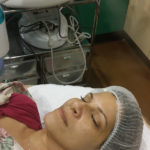 Beauty care is an art and a science in today’s world. You can choose between ancient solutions women have been using for a millennia or new solutions created with the help of modern science. And everything in-between!
Beauty care is an art and a science in today’s world. You can choose between ancient solutions women have been using for a millennia or new solutions created with the help of modern science. And everything in-between!
If you are bewildered by the choices, here are some guidelines to help you choose between a facial, a chemical peel, and finally which type of chemical peel to choose.
What Is A Facial
A facial is a soothing and nurturing treatment. It is deeply relaxing and enjoyable. Facials come in all different flavors from pumpkin masks to clay-based facials. Many skin care specialists even have signature facials with a special home brew of ingredients. Facials generally cleanse, moisturize and infuse the skin with beneficial vitamins and minerals. We can all benefit from a good facial. If you are blessed with wonderful skin that is smooth, soft, and make you look about ten years younger, then you may never want or need to jump over to a chemical peel. A facial may be just what you need.
What Is A Chemical Peel
 Chemical peels are facials that fix little problems. Most of us are not endowed with perfect skin. We get wrinkles, acne, blemishes and have a host of other skin problems. This is where chemical peels do wonders. Chemical peels can be exceptionally good at dealing with common skin problems such as acne and blemishes.* The acids (don’t get nervous, we’ll explain later) in chemical peels remove the top layers of the skin where many of these problems exist and reveal the fresh youthful skin below.
Chemical peels are facials that fix little problems. Most of us are not endowed with perfect skin. We get wrinkles, acne, blemishes and have a host of other skin problems. This is where chemical peels do wonders. Chemical peels can be exceptionally good at dealing with common skin problems such as acne and blemishes.* The acids (don’t get nervous, we’ll explain later) in chemical peels remove the top layers of the skin where many of these problems exist and reveal the fresh youthful skin below.
Skin is constantly being replenished by our bodies. When you peeling off the top layers, your body works to replace them with new layers of skin. That does not mean go crazy with chemical peels, but does mean that you can use them regularly as a beauty skin treatment.
Types of Chemical Peels
When trying to choose between chemical peels you generally have three options: lactic, glycolic, and salicylic. When choosing between these three options there are a few considerations. First, you need to consider the type of skin problem you are trying to solve. Second, you need to be aware of your own skin sensitivity. Third, you need to gauge your comfort level. None of the peels are inherently dangerous, but if you are a first timer, you may want to start start off conservatively by choosing the mildest peel option, then work progressively towards your skin care goals.
The peels come in solutions ready to be applied by the skin care specialist. The acidic solutions used in skin care have been carefully formulated and tested. Of the three types of peels, lactic peels are the mildest, followed by glycolic, then salicylic.
Lactic: The Mild Chemical Peel
The lactic peel can be a great choice for the first time peel and mild and annoying skin problems. Are you seeing the first few fine lines of age? Feeling the summer of city grime getting under your pores? See a couple of pimples from the ice cream cake that was too good to pass up? These are all good reasons for a lactic peel. The lactic peel also lightens and brightens the skin, so if you just want a brighter fresher you, this is the one to choose.
Glycolic: A Moderately Aggressive Chemical Peel
Okay, so you have gone in and had your lactic peel and come out with a good experience. Now you want to address some of those skin care problems you have been facing. This is the next step up in power and capabilities. A glycolic peel can be a great solution to moderate skin problems. We all get overexposed to the sun from time to time and end up with sum blemishes. Glycolic peels are excellent for removing them and smoothing the complexion. Glycolic peels help with fine lines just like the lactic peel, but treats them a little more aggressively.
Salicylic: The Most Aggressive Of The Spa Peels
The salicylic peel is the strongest type of peel that you generally find at a spa or skin care clinic. Formulated for oily, acne-prone skin types, this peel helps in the prevention of sebum blockage, the primary cause of acne and other skin problems associated with the sebaceous gland, such as ingrown hairs. A salicylic peel is also anti-bacterial and anti-inflamatory. Extractions are significantly easier post Salicylic Acid Peek. This peel can also be great for the prevention of ingrown hairs, antibacterial, anti-inflammatory. Before choosing a salicylic peel you should consult with a qualified skin care specialist to see if it is the right course of action.
It Has Never Been Easier To Have Great Skin
With all these choices it has never been easier to have great skin. Facials and chemical peels are wonderful for maintaining a vibrant and youthful complexion and solving a variety of common skin problems. If you have not tried a facial or a chemical peel you should. They are not that expensive, and they do wonders for how you look as well as your outlook.
Further Readings
Please see the following article for more scientific discussion of the uses and benefits of chemical peels: Evidence and Considerations in the Application of Chemical Peels in Skin Disorders and Aesthetic Resurfacing. There are many more article on the same website that discuss chemical peels and their effects on skin disorders and related topics.
*Results may vary from person to person. Results are not guaranteed.
DISCLAIMER: The content on this website is for informational purposes only. Read full disclaimer here.
